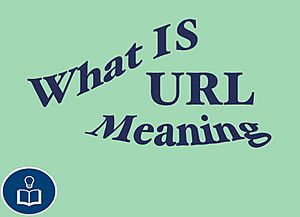Uniform Resource Locator facts for kids
A Uniform Resource Locator (URL) is simply a web address. Think of it like a street address for a house, but for information on the internet! URLs are made of letters, numbers, and other special symbols. They follow a specific format. People use URLs on computers to find and show a certain piece of information. This is usually a web page from another computer called a web server. You can type a URL into your web browser. More often, you just click on a link you see on a web page.
Contents
What Makes Up a URL?
A URL has a few important parts that help your computer find the right place.
The Protocol
- The first part is usually a protocol. This is like the language your computer uses to talk to the web server.
- A very common protocol is the Hypertext Transfer Protocol (HTTP). You might see https which means it's a secure connection.
- After the protocol, you'll see `://`. This separates the protocol from the rest of the address.
The Website Name
- Next comes the name or address of the other computer (the web server).
- Many website names start with www. which stands for World Wide Web.
- The full name is chosen by the people who manage that computer.
Other Parts of a URL
Sometimes, a URL can have even more parts to help find specific content:
- The path to a document or file. This is like telling your computer which folder to look in.
- Extra details after a question mark (?). These are often used for search results or specific settings.
- A username and password, if a page needs special access.
- Text after a pound sign (#). This tells your browser to jump to a specific spot on a long page.
For example, the URL for this page is `https://facts.kiddle.co/Uniform_Resource_Locator`.
- `https` is the protocol.
- `facts.kiddle.co` is the website name.
Understanding URL Extensions
URL extensions are found at the very end of a website's name, after a period. They are also called top-level domains. These extensions tell you more about the website.
Common Extensions
When the internet first started, there were six main extensions:
- `.com` - Used for commercial websites, like businesses.
- `.net` - Often used for networks or internet service providers.
- `.org` - For organizations, usually non-profit groups.
- `.edu` - For educational institutions, like schools and universities.
- `.mil` - Used by the Military.
- `.gov` - For governmental websites.
Country and Interest Extensions
Today, there are many more URL extensions.
- Each country has its own top-level domain. For example, `.ca` is for Canada, `.us` is for the United States, and `.co.uk` is for the United Kingdom.
- Many countries also have special extensions for their government websites. For instance, the United States uses `.gov` or `.fed.us`.
- There are also extensions for specific interests, like `.tv` for television-related sites or `.pro` for professionals. These are not as common as the original extensions.
See also
In Spanish: Localizador de recursos uniforme para niños



